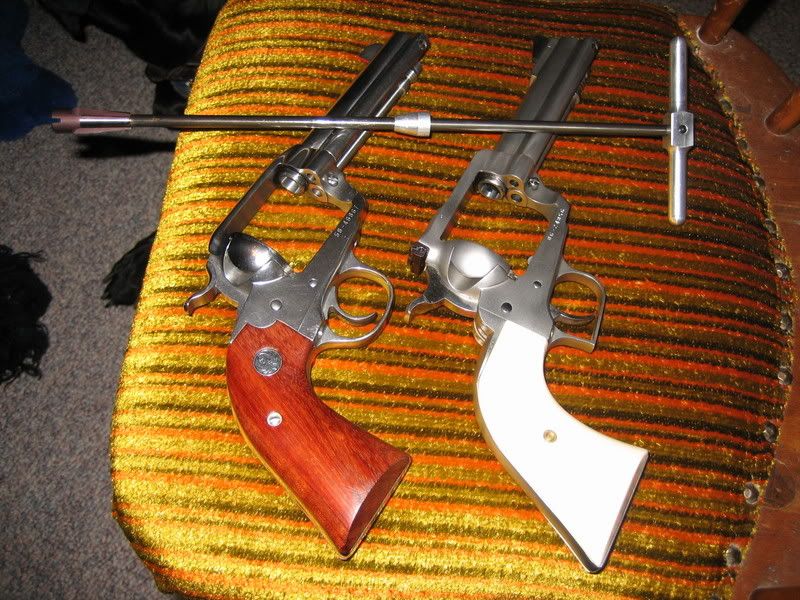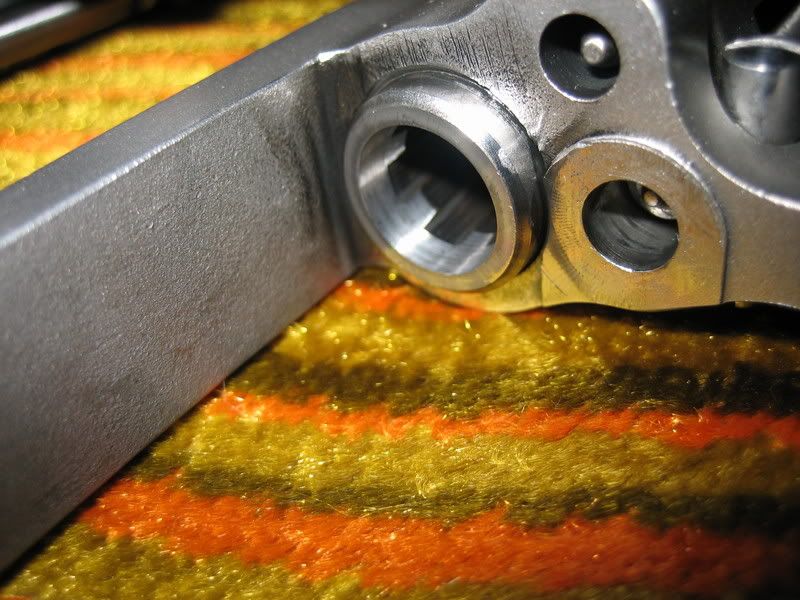Why is 11 deg. considered the ideal bevel on a forcing cone?
OT - Forcing cone ?
Forum rules
Welcome to the Leverguns.Com General Discussions Forum. This is a high-class place so act respectable. We discuss most anything here other than politics... politely.
Please post political post in the new Politics forum.
Welcome to the Leverguns.Com General Discussions Forum. This is a high-class place so act respectable. We discuss most anything here other than politics... politely.
Please post political post in the new Politics forum.
OT - Forcing cone ?
Question for you Knowledgeable revolver guys. 
Why is 11 deg. considered the ideal bevel on a forcing cone?
Why is 11 deg. considered the ideal bevel on a forcing cone?
The way I understand it, the target shooters determined that it was the optimal angle for lead bullets. Jacketed work well too.
I think the best thing about it is how nice it cleans up any imperfections the factory left.
I think the best thing about it is how nice it cleans up any imperfections the factory left.
ScottS

"No arsenal, no weapon in the arsenals of the world, is so formidable as the will and moral courage of free men and women."
-- Ronald Reagan

"No arsenal, no weapon in the arsenals of the world, is so formidable as the will and moral courage of free men and women."
-- Ronald Reagan
- J Miller
- Member Emeritus
- Posts: 14906
- Joined: Sat Mar 31, 2007 7:46 pm
- Location: Not in IL no more ... :)
Scott sure has this part right. I'm not sure exactly why the 11* forcing cone is so popular. I do know that it is a gentle angle to the bullets and when done right really does guide the bullets into the bore without deforming them.I think the best thing about it is how nice it cleans up any imperfections the factory left.
Some of the more abrupt forcing cone angles aren't much better than no forcing cone at all.
I redid the forcing cone on my OM BH .45 last year and the difference was significant. Less leading was the most obvious improvement.
I can't say there is better accuracy yet, but the accuracy did not deteriorate. The groups are also a bit more consistent.
Joe
***Be sneaky, get closer, bust the cap on him when you can put the ball where it counts  .***
.***
- J Miller
- Member Emeritus
- Posts: 14906
- Joined: Sat Mar 31, 2007 7:46 pm
- Location: Not in IL no more ... :)
Brownells sells piloted brass laps to polish forcing cones. The only thing is you have to know what angle forcing cone you have so you don't use the wrong lap.claybob86 wrote:If a forcing cone has circular tool marks left from the factory, would it be a good idea to polish those out by hand, or would that need to be done on a machine to preserve concentricity? I have one like that, but not sure if I should mess with it.
The piloted tool consists of a rod with pilots sized to the bore that center the rod. The rod has a T- handle on the outside end. The forcing cone cutter threads on the forcing cone end and you gently pull the rod and put a little pressure against the old forcing cone as you turn the cutter. The cutters are very sharp and cut through the steel fast.
Now, to polish or lap the forcing cone you use the same piloted rod but substitute a polishing lap for the cutter. It's easy to do really. I did mine even have some pics somewhere.
Joe
***Be sneaky, get closer, bust the cap on him when you can put the ball where it counts  .***
.***
Here is the tool that Joe is talking about.

And this is what the new 11 deg. forcing cone will look like.

As far as polishing your existing forcing cone, like Joe said, it is very important to have the same angled lap. From what I have read the last thing you want to create is a compound angle forcing cone.

And this is what the new 11 deg. forcing cone will look like.

As far as polishing your existing forcing cone, like Joe said, it is very important to have the same angled lap. From what I have read the last thing you want to create is a compound angle forcing cone.
ScottS

"No arsenal, no weapon in the arsenals of the world, is so formidable as the will and moral courage of free men and women."
-- Ronald Reagan

"No arsenal, no weapon in the arsenals of the world, is so formidable as the will and moral courage of free men and women."
-- Ronald Reagan
-
foxtrapper
- Levergunner 2.0
- Posts: 420
- Joined: Wed Sep 12, 2007 9:45 am
- Location: Long Island N.Y.
Brownells # 080-479-451
http://www.brownells.com/aspx/NS/store/ ... ING%20KITS
http://www.brownells.com/aspx/NS/store/ ... ING%20KITS
ScottS

"No arsenal, no weapon in the arsenals of the world, is so formidable as the will and moral courage of free men and women."
-- Ronald Reagan

"No arsenal, no weapon in the arsenals of the world, is so formidable as the will and moral courage of free men and women."
-- Ronald Reagan
-
foxtrapper
- Levergunner 2.0
- Posts: 420
- Joined: Wed Sep 12, 2007 9:45 am
- Location: Long Island N.Y.
I appreciate those pictures Salvo. I have read a lot about that but never seen it in person. I can see where it might help with leading.
Is what you pictured the "Basic Chamfering Kit" and how hard is it to use for a shadetree gunsmith??
Is what you pictured the "Basic Chamfering Kit" and how hard is it to use for a shadetree gunsmith??
Derek aka "shootnfan"
Middle Tennessee
24 hours in a day.....24 beers in a case. Coincidense? I think not.
Middle Tennessee
24 hours in a day.....24 beers in a case. Coincidense? I think not.
Your welcome foxtrapper!
Yes it is the 11 deg. .38-.45 BASIC CHAMFERING KIT.
Very easy to use and like Joe said it cuts fast. Just go slow and as soon as the old forcing cone is gone, your done.
I wrote a Ruger Tune Up at the old forum, here is a copy of it over at Single-Actions.
http://single-actions.phpbb3now.com/vie ... ?f=8&t=307
Yes it is the 11 deg. .38-.45 BASIC CHAMFERING KIT.
Very easy to use and like Joe said it cuts fast. Just go slow and as soon as the old forcing cone is gone, your done.
I wrote a Ruger Tune Up at the old forum, here is a copy of it over at Single-Actions.
http://single-actions.phpbb3now.com/vie ... ?f=8&t=307
ScottS

"No arsenal, no weapon in the arsenals of the world, is so formidable as the will and moral courage of free men and women."
-- Ronald Reagan

"No arsenal, no weapon in the arsenals of the world, is so formidable as the will and moral courage of free men and women."
-- Ronald Reagan
- J Miller
- Member Emeritus
- Posts: 14906
- Joined: Sat Mar 31, 2007 7:46 pm
- Location: Not in IL no more ... :)
Derek,
When I did my forcing cone I put the barrel in a padded vise muzzle down and then pushed the tool rod up from the bottom.
I attached the cutter and gently let it down in the old forcing cone.
Then I made sure the pilot was in the muzzle and turned the handle. I barely put any pressure on the cutter. After each turn I inspected the cut and cleaned it off, then made another cut.
I forgot how many cuts I did, but I wanted to be careful to not cut too much.
I probably could have cut more, but I got a full cleaned up forcing cone and quit.
Joe
When I did my forcing cone I put the barrel in a padded vise muzzle down and then pushed the tool rod up from the bottom.
I attached the cutter and gently let it down in the old forcing cone.
Then I made sure the pilot was in the muzzle and turned the handle. I barely put any pressure on the cutter. After each turn I inspected the cut and cleaned it off, then made another cut.
I forgot how many cuts I did, but I wanted to be careful to not cut too much.
I probably could have cut more, but I got a full cleaned up forcing cone and quit.
Joe
***Be sneaky, get closer, bust the cap on him when you can put the ball where it counts  .***
.***
-
Nate Kiowa Jones
- Site Sponsor
- Posts: 2508
- Joined: Fri Sep 07, 2007 12:05 pm
- Location: Lampasas, Texas
- Contact:
The 11 degree cone is much easier on lead bullets for sure. Think of it like this. It's a funnel. Old style funnels had steep angles and if you poured into it too fast it sloshed over. The 11 degree cone is more like the long or tall sided funnels that allow you to pour faster with out sloshing over. When I do action work for CAS SAA’s I always include the 11 degree cones.
A word of caution though, some of the CAS shooters load the really short 165 grain 45’s and even 90 grain 380 bullet for 38 specials trying to beat the recoil. Long 11 degree forcing cones cut too deep can actually cause the gun to shoot less accurate and lead even more. This is because the back of the bullet is not supported long enough to allow the front to stabilize into the barrel.
No one mentioned it but it's important to use a good cutting fluid when using this cutter. Makes for a much smoother cut, less leading.
A word of caution though, some of the CAS shooters load the really short 165 grain 45’s and even 90 grain 380 bullet for 38 specials trying to beat the recoil. Long 11 degree forcing cones cut too deep can actually cause the gun to shoot less accurate and lead even more. This is because the back of the bullet is not supported long enough to allow the front to stabilize into the barrel.
No one mentioned it but it's important to use a good cutting fluid when using this cutter. Makes for a much smoother cut, less leading.
Steve Young aka Nate Kiowa Jones Sass# 6765
Steve's Guns aka "Rossi 92 Specialists"
205 Antler lane
Lampasas, Texas 76550
http://www.stevesgunz.com
Email; steve@stevesgunz.com
Tel: 512-564-1015

Steve's Guns aka "Rossi 92 Specialists"
205 Antler lane
Lampasas, Texas 76550
http://www.stevesgunz.com
Email; steve@stevesgunz.com
Tel: 512-564-1015

